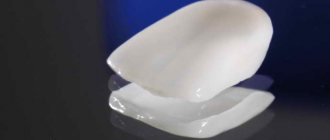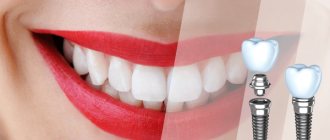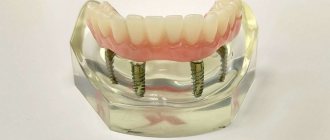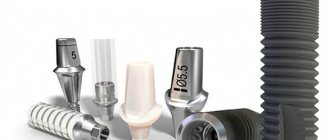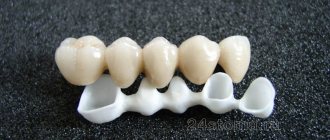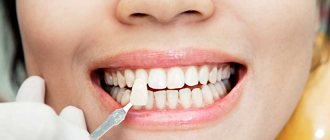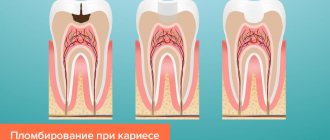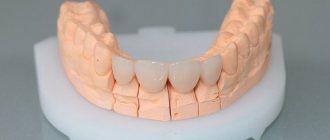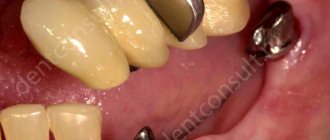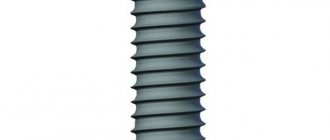December 7, 2020 Last revised: January 10, 2020 Dental diseases
Modern dentistry has a large arsenal of high-quality materials for filling teeth. What kind of filling should I put in order to reliably preserve the dental crown from destruction - plastic or ceramic, silicate or cement, chemical or light? Let's take a closer look at the different types of filling material and answer the question which filling is better.
Popular dental materials
Fillings are divided into permanent and temporary. A permanent one is placed when there is minor damage to the tooth crown, a temporary one is used for long-term complex treatment or diagnostics. A temporary filling is also used to protect medicinal compounds during dental treatment: a medicinal compound is placed under it.
The materials from which fillings are made are divided into several types:
- cement, silicate;
- plastic;
- metal, amalgam;
- ceramics;
- composites.
Depending on the material used, fillings are divided into several main types:
- cement;
- composite;
- compomers.
The dental industry also produces other types of fillings - plastic, metal and ceramic.
The most durable material is made from light-curing composite. Such fillings are expensive, but the high price justifies the long service life. The fillings look aesthetically pleasing and have the ability to change their shade with changes in lighting.
The most popular material is dental cement. These fillings are still in demand among patients due to their low cost, high adhesion and strength. The fillings literally stick to the surface of the crown and do not form air gaps.
Light-curing filling: reviews
Judging by the reviews of people who installed a light filling, it is completely invisible in the oral cavity. If the doctor did his job professionally, then no one will even be able to guess which tooth the composite is on. This material has long proven itself to be positive, and patients are very satisfied with the results of treatment. Negative reviews, if any, are related to the cost of installing a light seal.
Cement materials
Cement differs significantly from composite in its lower hardness, however, it is able to protect the tooth from repeated carious development. A disadvantage is the high density of cement compared to tooth tissue: over time, this contributes to the thinning of the crown surface adjacent to the filling.
Cement compositions have three subtypes, according to additives to the main ingredient:
- silicate;
- phosphate;
- glass ionomer.
Silicate compounds are the oldest of all. The material contains special glass mixed with phosphoric acids. The silicate composition has a different release of fluoride, which prevents the development of dental caries. The harmfulness of the material lies in its aggressive phosphoric acid, which destroys the pulp. To neutralize the effect of acid on the pulp tissue, a special gasket made of safe substances was installed.
Phosphate compounds are characterized by fragility and fragility, weak adhesion (adhesion to tooth tissue), and high abrasion. The peculiarity of these fillings is their high toxicity, which provokes the proliferation of aggressive bacteria. This substance (phosphate) does not protect well against the re-development of caries.
Glass ionomer cement is used to treat children. The substance is as close in texture as possible to dental tissue, has high adhesive characteristics and safety. The glass ionomer is illuminated with a special ultraviolet lamp, which promotes rapid hardening of the material and high-quality tooth protection from infection. The advantages of this material include the fluoride contained in the composition, which protects against the development of recurrent caries.
The disadvantages include fragility - softness and instability of the composition. In modern dentistry, strengthened glass ionomer is used, the composition of which is supplemented with metal or ceramic particles. This material is used for filling chewing molars; it is most resistant to abrasion. The last word in the development of dental materials is the production of nanoionomer, which reliably protects dental tissue from infection and the development of caries.
What determines the service life
A light-curing filling can last up to 5 years and no problems will arise with it. But of great importance, for example, is the diet that the patient will adhere to after this. A high content of carbohydrates in the diet reduces this indicator, but the inclusion of plant foods in it, on the contrary, allows it to last for as long as possible. In this case, good grip is guaranteed by several factors:
- Under the influence of ultraviolet radiation, a chemical process occurs between the filling and the tissues of the tooth itself with the help of calcium;
- Before installing the filling, the tooth body is treated with adhesive, which is also illuminated with a lamp.
To ensure that the service life of the light seal is not reduced, the specialist must follow the technology in the smallest detail, which requires excellent professional training. Contact either a trusted clinic or an institution that has a good reputation in your city.
Composite compounds
Chemically cured composites were invented as an alternative to simple cement fillings. The composition of the composite includes porcelain, which gives greater strength to the cement. Also, according to their composition, composites are divided into three types:
- acrylic-containing;
- resin (epoxy);
- light-curing.
Of the listed compositions, the acrylic-containing composite has the greatest strength. These fillings are characterized by wear resistance, are little susceptible to abrasion, however, they have a toxic effect on the body. Due to toxicity, acrylic is contraindicated in many patients. Acrylic also often provokes the formation of pulpitis. Another negative feature of acrylic is its high absorbency, due to which the risk of caries increases significantly.
Resin composite material is not highly wear-resistant and durable, however, it is non-toxic and harmless to the body. The disadvantages of resin structures include a change in color after a few years: the fillings darken. Another feature of resin (epoxy) fillings is their excessive fragility: they can break off and be “eaten.” Therefore, it is better not to use epoxy composition on primary chewing molars. Epoxy composite also provokes the development of pulpitis, just like acrylic.
The light-curing composite gains its strength from a halogen lamp. They are also called photopolymer or solar-cured. The disadvantage of this material is the complexity of installation: polishing and grinding of the material is necessary. The filling must be polished every six months to maintain the original tone of the material.
What other disadvantages are typical for this material? These include the following properties of the filling:
- shrinkage after curing;
- possible chipping of the crown wall;
- poor-quality hardening of the material.
The filling can shrink up to five percent of its original volume, which significantly reduces the effectiveness of protecting the tooth. Even with slight shrinkage of the filling, there is a high probability of chipping of the adjacent wall of the dental crown. Due to the technical difficulties of working with a halogen lamp, the hardening of the material may be incomplete - only 70%.
An innovation in modern dentistry is a nanocomposite, the structure of which consists of tiny particles. The nanocomposite is characterized by high adhesion to tooth tissues, providing reliable protection against infection and the spread of caries.
Installation
Before a light-curing filling is placed, the teeth are first prepared. They undergo initial processing, if necessary, expand the canals, clean them and seal them.
For the installation itself, a modern composite material is used, which is used to perform modeling in order to restore a damaged tooth. After this, it is exposed to ultraviolet light to harden the filling. The tooth is then polished, ground and varnished.
It is important to know that the material hardens quite quickly, and this can cause high stress inside the tooth and it can crack. Therefore, the photopolymer should be applied gradually, in layers. Light-curing materials are most often packaged in carpules or disposable syringes. This greatly simplifies the dentist’s work, because there is no need to mix all components before installation. It is also safe and sterile.
Such a filling can be installed even during pregnancy, since it is not capable of causing harm to either the expectant mother or her baby.
A very important point - when can you eat food after installing the filling material? This should be done after 1-2 hours, only in this case the filling will last long enough. If, after installing the light material, your tooth begins to hurt, you should consult a doctor, because there is a high probability of a medical error.
Plastic, metal and ceramic compounds
Plastic fillings are also at the peak of popularity, also due to their low price. Plastic has many disadvantages:
- gives significant shrinkage after curing;
- changes its color over time;
- quickly wears out and becomes unusable;
- poorly protects against secondary caries.
Important! Cement and plastic fillings are placed in free dental clinics.
Ceramic compositions
The distinctive characteristics of this material are high strength, lack of shrinkage and aesthetics. Ceramics does not darken during use and is not painted. In modern dentistry, ceramics is considered an almost ideal filling material. Types of ceramics include:
- transparent material;
- pressed material;
- metal ceramics.
The disadvantages include the difficulty of installation: the composition fills the hole in the tooth, like an inlay. The inlay is formed using an impression of a previously sanitized tooth.
Metal alloys
Amalgam material includes a mercury compound along with silver. The dangers of exposure to mercury in the body pose a certain health risk. The advantage of amalgam is its long service life and abrasion resistance.
Another disadvantage of this material is expansion during hardening. If the dentist does not correctly calculate the volume of the filling, the possibility of slight destruction of the crown cannot be ruled out.
Due to the unaesthetic appearance of metal structures, they are used on back teeth or the hidden surface of the crown.
Price issue
How much does a light-curing filling cost? The price of the material depends on the severity of the disease. If the tooth is severely damaged and is in the visible zone, then the doctor will have a lot of work to do. The cost of installing a light seal depends on the amount of work and the amount of material used. Therefore, the sooner the patient sees a doctor, the lower the price of the service provided will ultimately be.
The pricing policy also depends on how experienced the doctor installing the light filling is. The higher his professionalism, the higher the cost of his work will be, while the patient receives a guarantee that the restored tooth will last several times longer.
On average, the cost of a light polymerization filling is 800-3500 rubles. In severely advanced cases, the price increases significantly. In addition, if the installation is carried out on the front teeth, then the cost of the work will also be rather high.
Proper care
Following oral care recommendations after installing photopolymer fillings will help consolidate the results and extend their service life.
In the first days after filling, experts recommend:
- refrain from drinking coloring drinks (berry juices, coffee), using lipstick or toothpaste containing dye to avoid changing the shade of the material. For the same reason, it is advisable to give up cigarettes and alcoholic beverages;
- give up sodas and solid foods, which place increased stress on the filling;
- rinse your mouth with an antiseptic solution or a decoction of medicinal herbs (chamomile, calendula).
In addition, immediately after installing a composite filling, dentists do not recommend eating for one to two hours due to the fact that additional time may be required for the final hardening of the composition.
A timely visit to the dentist for preventive examinations will help to identify and eliminate minor damage in a timely manner, and if you follow the care recommendations, photopolymer fillings can last up to seven years, which fully pays for their high cost in comparison with other materials.
